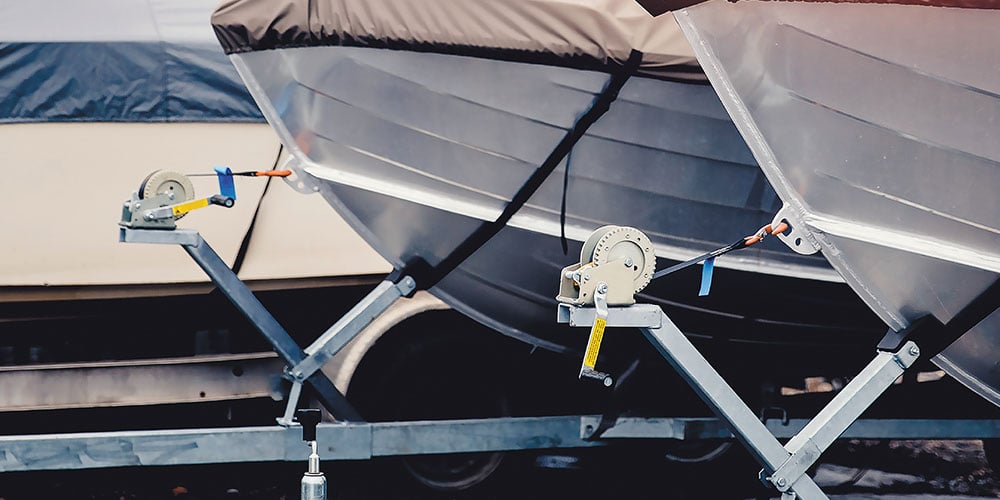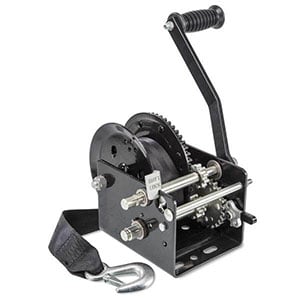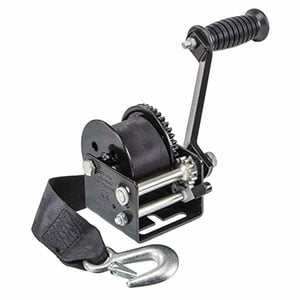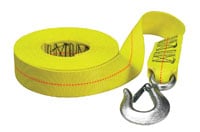
Trailer winches let you pull your boat onto the trailer while it’s on an inclined launching ramp. Winches are mounted on a dedicated winch stand on the trailer tongue, on the support for the bow stop or on the trailer’s hitch ball using an adapter plate. A reel or spool holds 20–50 feet of cable, rope or webbing, and has a snap at the bitter end. With the snap clipped onto the bow eye of the boat, the winch operator can either crank the boat onto the trailer or allow the boat to slide backwards into the water at a controlled rate. We'll walk you through common considerations to find the one that will work best for you.
- Manual Trailer Winches
- Your Boat's Environment
- Winch Weight Capacities
- Single-Speed or Two-Speed Winches
- Winch Straps
- Trailer Safety Tips
Manual Trailer Winches

West Marine's 2600 lb. Two Speed Manual Trailer Winch with Strap

West Marine's 900 lb. Manual Trailer Winch with Strap
Hand-cranked manual winches multiply your strength, allowing you to pull a relatively heavy boat against gravity and friction. They also have a ratchet to hold the boat at any point on the trailer so it doesn’t slide back into the water, allowing a normal person to retrieve a boat weighing over a ton using a crank about a foot long and simple gearing. Larger models have a lower gear ratio to multiply your strength even more and two speeds for extra power.
Your Boat's Environment
Do you use your boat in a freshwater lake or in saltwater? Is the winch galvanized, zinc-plated, powder-coated or aluminum? Look at how many hours of saltwater exposure the winch is rated to survive.
Winch Weight Capacities
Winches are rated by their weight capacity, not by the length of the boat. Choose a trailer winch to fit the weight of your boat, motor and equipment. Heavier and longer boats require more powerful winches with longer cables.
The general rule is to select a winch with a capacity rating of at least 3/4th the combined weight of your boat, motor, fuel and gear. This rule varies depending on a number of factors about your boat and where you launch it.
Do you typically launch on steep ramps? Is your trailer equipped with carpeted wood bunks instead of rollers? If so, the load on the winch will be higher, and you should select a winch with capacity closer to the actual weight of the fully-equipped boat. Launching ramps that are gently sloped, or trailers equipped with rollers result in less resistance, so you can choose a smaller winch. However, since the difference in price between winch sizes is pretty minimal, you can choose a bigger winch for nearly the same cost. We also recommend Glyde Sliks, EZ Slides or similar anti-friction pads on your trailer’s bunks, which help your boat slide.
Most trailers have a standard winch assembly bolt pattern, so upgrading to a stronger winch is easy if the current winch is inadequate.
Single-speed or Two-speed Winch
How much cranking resistance is there when you pull your boat? For lighter boats like dinghies, inflatables and catamarans, a manual winch with a 3:1, 4:1 or 5:1 gear ratio may be all you need. For heavy-duty work we recommend two-speed winches. Fulton’s highest capacity model of their F2 Manual Winches gives you fast speed, with a 5:1 gear ratio for quick pull-in, and a second low speed, with 16.2:1 ratio, for increased mechanical advantage. A ratio of 5 to 1 means that you turn the handle five times to get the drum to rotate once.
Winch Straps

We like polyester winch straps like this one from Boat Buckle (rated for up to 5,500lb.) because it doesn’t scrape the bow of our boat or hurt our crew’s hands.
Small manual winches designed for lighter boats generally use polypropylene rope or nylon straps. Polyester straps are also a great choice for their high weight load and for the fact that they won't scrape the bow of your boat.
Trailer Winch Safety Tips
- Trailer winches are not tiedowns. To prevent mishaps, use dedicated bow, gunwale and stern tiedowns to secure your boat on the trailer. For large boats add a safety chain to the bow eye.
- Make sure you have secure footing and proper leverage when using manual winches. Slips and falls by winch operators and injuries from winch handles that kick back are common boat ramp accidents.
- To avoid chafe on the winch line, be sure it doesn’t rub against any sharp edges on the winch stand or trailer. If frayed or worn spots appear, replace the winch line immediately with a new rope, strap or cable of the proper type, size and strength. Cable life can be extended by frequently lubricating it with wire rope lubricant so the strands of cable slide by each other with less friction. Lubricating your winch cable will also reduce the number of snags and frays in the cable.